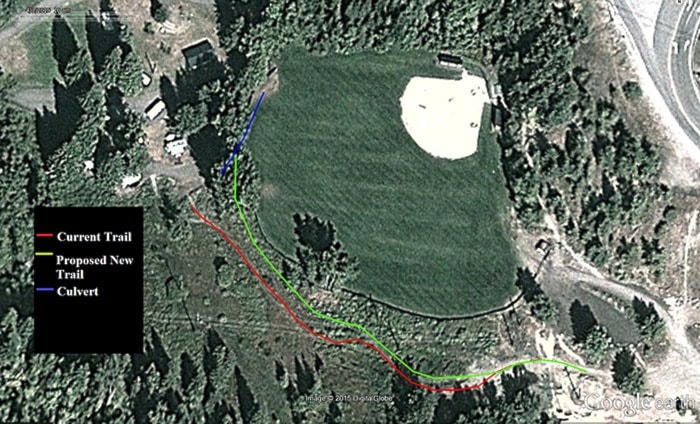Chelsea Novak
Rossland News
The Centennial Park wetlands reverberate with the trilling of birds and the hiss of thousands of male grasshoppers singing at once.
Trees, wildflowers, too many plant species to begin to name, and animals and insects — both hidden and visible, singing and silent — call the wetland home, but so do a number of power poles, manholes, and human recreation areas.
The Centennial wetland is a wet-meadow with ephemeral ponds, which means they are only full of water for part of the year. This type of wetland is rare in the Kootenays and can support a diversity of plant and animal species. The problem is that human impacts — in this case land filling, sewer line construction, and off-road vehicles — have disrupted the natural water table in the wetland, causing water to drain out of the area and more quickly contribute to flooding further down Trail Creek.
Melissa LaFace and Eva Cameron are two of the people working to restore the Centennial Park wetland, and they appeared before Rossland city council last week to present their plan.
LaFace got involved with the restoration for a planning project for the Integrative Environmental Planning program at Selkirk College. Cameron is a landscape designer by trade, and was also involved with the Jubilee wetland restoration.
One of the key goals of the Centennial restoration is to keep Rosslanders and tourists from encroaching further on the wetland.
Currently, the wetland is bordered by a bike skills park, a baseball field, and the Lions Campground and as it stands, both the skills park and the campground could continue to push into the wetland.
“[The skills park] has no parameters,” says Cameron. “So in the last couple of years they’ve sort of pushed right to the edge of the wetland and cut all the willows that were stabilizing the steep banks, and then in the high rains there’s sediment and silt pouring down into the wetland.”
The Lions have also proposed expanding their campsite, which would mean pushing further into the wetland.
LaFace and Cameron are asking for support from Rossland city council to set parameters for the facilities bordering the area, preventing further infill and encroachment.
They also want to divert the trail that currently cuts through the wetland, so that it runs where there’s already been infill.
“Right now [the trail] is running through the wetland a bit,” says LaFace. “And ... dirt bikers and quaders have been going through there.”
That’s a problem because the tire tracks disrupt the water table by creating head-cuts.
A head-cut is a drop in the wetland where a natural mini waterfall forms and is the result of unnatural erosion — in this case caused by the ruts left by vehicles or by the intentional creation of ditches. The mini waterfall speeds up water flow through the wetland, helping to drain it that much faster.
Head-cuts, once they’ve formed, will continue to grow, as the rushing water causes further erosion. So one of the first priorities is to block the existing head-cuts with debris — think Beaver dam — and keep them from spreading.
Another big part of the project is to replace some of the aging infrastructure in the area, and hopefully move it out of the wetland, where it can be accessed without disrupting the water table.
The water main that runs through the area is old and needs to be replaced, as is a culvert that runs beside the ballpark. LaFace and Cameron have proposed day-lighting the stream under the culvert, which just means the culvert would be removed, and the stream could run freely.
They also want to seal the manholes, not only to keep sewage from seeping into the wetland, but to keep water from draining out of the wetland through the sewage line.
Keeping water out of the sewage system won’t just benefit the wetland, but also the city’s budget.
“Right now they’re doing smoke testing for that whole sewer line to see where there are leaks and where there might be water going in, and water coming out,” explains Cameron. “And a big reason they’re doing that is because we’re being charged for every amount of water that’s in the sewer line and needs to be treated.”
LaFace and Cameron hope that restoring the Centennial wetland will not only help restore the natural water table, and preserve this rare environment, but that it might also help bring back a long-lost Rossland native.
“We’ve had reports of locals who’ve seen the painted turtles in past years in areas that have now been drained and diverted, so we hope that they come back,” says Cameron.
